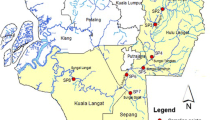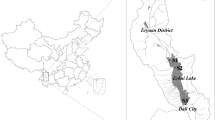Abstract
Natural steroid hormones in the aquatic environment have attracted increasing attention because of their strong endocrine disrupting potency. Seven steroid hormones (estrone, 17α-estradiol, 17β-estradiol, estriol, testosterone, androstenedione, and progesterone) were analyzed from surface water and sediment sampled from Chaohu Lake, its upstream rivers (the Hangbu River, Nanfei River, Shiwuli River, and Pai River), drainage from the adjacent farmland, and treated and untreated municipal sewage. Concentrations of the seven target steroid hormones ranged from below the detection limit (ND) to 69.5 ng L−1 in the water of Chaohu Lake and the upstream rivers. Three steroids—estrone, estriol, and 17α-estradiol—were found in relatively high residual concentrations in the water, with maximum concentrations of 69.5 ng L−1, 51.5 ng L−1, and 23.3 ng L−1, respectively. All of the target steroid hormones except estriol were detected in the sediment in concentrations of ND–16344 ng kg−1. The dominant steroid hormone in the sediment of Chaohu Lake and the upstream rivers was 17α-estradiol. In the Shiwuli River and the Pai River, the dominant steroid hormones (estrone and estriol) were the same as those in the untreated municipal sewage. This confirmed the deduction that untreated municipal sewage was the major source of steroid hormone residues in these two rivers. The main steroid hormone in the water of the Hangbu River and Chaohu Lake was 17α-estradiol, the same as that in the farmland drainage. In addition, 17α-estradiol was verified as the major factor in the contribution of farmland drainage to the pollution in these rivers. The water in the Nanfei River had high concentrations of estriol and 17α-estradiol. This indicates that both untreated municipal sewage and farmland drainage were the major sources. The discharge of steroid hormones from the four rivers to Chaohu Lake was approximately 75.1 kg year−1, with the highest contributor being 17α-estradiol (24 kg year−1). Therefore, based on the results of this study, the farmland drainage should be controlled to reduce the steroid hormone pollution in Chaohu Lake.






Similar content being viewed by others
References
Abul-Hajj YJ, Qian X (1986) Transformation of steroids by algae. J Nat Prod 49:244–248
Adeel M, Song X, Wang Y, Francis D, Yang Y (2017) Environmental impact of estrogens on human, animal and plant life: a critical review. Environ Int 99:107–119
Biswas S, Kranz WL, Shapiro CA, Snow DD, Bartelt-Hunt SL, Mamo M, Tarkalson DD, Zhang TC, Shelton DP, van Donk SJ, Mader TL (2017) Effect of rainfall timing and tillage on the transport of steroid hormones in runoff from manure amended row crop fields. J Hazard Mater 324:436–447
Chang H, Wan Y, Hu J (2009) Determination and source apportionment of five classes of steroid hormones in urban rivers. Environ Sci Technol 43:7691–7698
Chang H, Wan Y, Wu S, Fan Z, Hu J (2011) Occurrence of androgens and progestogens in wastewater treatment plants and receiving river waters: comparison to estrogens. Water Res 45:732–740
DeLaune PB, Moore PA (2013) 17β-estradiol in runoff as affected by various poultry litter application strategies. Sci Total Environ 444:26–31
Gall HE, Sassman SA, Lee LS, Jafvert CT (2011) Hormone discharges from a midwest tile-drained agroecosystem receiving animal wastes. Environ Sci Technol 45:8755–8764
Gong J, Huang Y, Huang W, Ran Y, Chen D (2016) Multiphase partitioning and risk assessment of endocrine-disrupting chemicals in the Pearl River, China. Environ Toxicol Chem 35:2474–2482
Guo L, Xie P, Ni L, Hu W, Li H (2007) The status of fishery resources of Lake Chaohu and its response to eutrophication. Acta Hydrobiologica Sinica 31:700–705
Hanselman TA, Graetz DA, Wilkie AC (2003) Manure-borne estrogens as potential environmental contaminants: a review. Environ Sci Technol 37:5471–5478
Hansen PD, Dizer H, Hock B, Marx A, Sherry J, McMaster M, Blaise C (1998) Vitellogenin – a biomarker for endocrine disruptors. TrAC Trends Anal Chem 17:448–451
Huang B, Wang B, Ren D, Jin W, Liu J, Peng J, Pan X (2013) Occurrence, removal and bioaccumulation of steroid estrogens in Dianchi Lake catchment, China. Environ Int 59:262–273
Huang B, Li X, Sun W, Ren D, Li X, Li X, Liu Y, Li Q, Pan X (2014) Occurrence, removal, and fate of progestogens, androgens, estrogens, and phenols in six sewage treatment plants around Dianchi Lake in China. Environ Sci Pollut R 21:12898–12908
Huang C, Zhang Z, Wu S, Zhao Y, Hu J (2010) In vitro and in vivo estrogenic effects of 17α-estradiol in medaka (Oryzias latipes). Chemosphere 80:608–612
Hutchins SR, White MV, Hudson FM, Fine DD (2007) Analysis of lagoon samples from different concentrated animal feeding operations for estrogens and estrogen conjugates. Environ Sci Technol 41:738–744
Jeon S, Hong S, Kwon B-O, Park J, Song SJ, Giesy JP, Khim JS (2017) Assessment of potential biological activities and distributions of endocrine-disrupting chemicals in sediments of the west coast of South Korea. Chemosphere 168:441–449
Kong X, He W, Qin N, Liu W, Yang B, Yang C, Xu F, Mooij WM, Koelmans AA (2017) Integrated ecological and chemical food web accumulation modeling explains PAH temporal trends during regime shifts in a shallow lake. Water Res 119:73–82
Kong X, Liu W, He W, Xu F, Koelmans AA, Mooij WM (2018) Multimedia fate modeling of perfluorooctanoic acid (PFOA) and perfluorooctane sulphonate (PFOS) in the shallow lake Chaohu, China. Environ Pollut 237:339–347
Lafrance P, Caron E (2013) Impact of recent manure applications on natural estrogen concentrations in streams near agricultural fields. Environ Res 126:208–210
Lee B, Kullman SW, Yost EE, Meyer MT, Worley-Davis L, Williams CM, Reckhow KH (2015) Predicting characteristics of rainfall driven estrogen runoff and transport from swine AFO spray fields. Sci Total Environ 532:571–580
Lei B, Huang S, Zhou Y, Wang D, Wang Z (2009) Levels of six estrogens in water and sediment from three rivers in Tianjin area, China. Chemosphere 76:36–42
Liu S, Ying G-G, Zhou L-J, Zhang R-Q, Chen Z-F, Lai H-J (2012) Steroids in a typical swine farm and their release into the environment. Water Res 46:3754–3768
Liu W-X, He W, Qin N, Kong X-Z, He Q-S, Yang B, Yang C, Jorgensen SE, Xu F-L (2015) Temporal-spatial distributions and ecological risks of perfluoroalkyl acids (PFAAs) in the surface water from the fifth-largest freshwater lake in China (Lake Chaohu). Environ Pollut 200:24–34
Liu Y, Lin Y, Yen C, Miaw C, Chen T, Wu M, Hsieh C (2018) Identification, contribution, and estrogenic activity of potential EDCs in a river receiving concentrated livestock effluent in Southern Taiwan. Sci Total Environ 636:464–476
Luo Q, Adams P, Lu J, Cabrera M, Huang Q (2013) Influence of poultry litter land application on the concentrations of estrogens in water and sediment within a watershed. Environ Sci: Processes Impacts 15:1383–1390
Nie M, Yan C, Dong W, Liu M, Zhou J, Yang Y (2015) Occurrence, distribution and risk assessment of estrogens in surface water, suspended particulate matter, and sediments of the Yangtze Estuary. Chemosphere 127:109–116
Peng F-Q, Ying G-G, Yang B, Liu S, Lai H-J, Liu Y-S, Chen Z-F, Zhou G-J (2014) Biotransformation of progesterone and norgestrel by two freshwater microalgae (Scenedesmus obliquus and Chlorella pyrenoidosa): transformation kinetics and products identification. Chemosphere 95:581–588
Raymond PA, Hartmann J, Lauerwald R, Sobek S, McDonald C, Hoover M, Butman D, Striegl R, Mayorga E, Humborg C, Kortelainen P, Durr H, Meybeck M, Ciais P, Guth P (2013) Global carbon dioxide emissions from inland waters. Nature 503:355–359
Rocha MJ, Cruzeiro C, Reis M, Pardal MÂ, Rocha E (2016) Pollution by oestrogenic endocrine disruptors and β-sitosterol in a south-western European river (Mira, Portugal). Environ Monit Assess 188:240
Routledge EJ, Sheahan D, Desbrow C, Brighty GC, Waldock M, Sumpter JP (1998) Identification of estrogenic chemicals in STW effluent. 2. In vivo responses in trout and roach. Environ Sci Technol 32:1559–1565
Shappell NW, Hyndman KM, Bartell SE, Schoenfuss HL (2010) Comparative biological effects and potency of 17α- and 17β-estradiol in fathead minnows. Aquat Toxicol 100:1–8
Sangster JL, Oke H, Zhang Y, Bartelt-Hunt SL (2015) The effect of particle size on sorption of estrogens, androgens and progestagens in aquatic sediment. J Hazard Mater 299:112–121
Shi J, Liu X, Chen Q, Zhang H (2014) Spatial and seasonal distributions of estrogens and bisphenol A in the Yangtze River Estuary and the adjacent East China Sea. Chemosphere 111:336–343
Shore LS, Shemesh M (2003) Naturally produced steroid hormones and their release into the environment. Pure Appl Chem 75:1859–1871
Slater CH, Schreck CB (1993) Testosterone alters the immune response of chinook salmon, Oncorhynchus tshawytscha. Gen Comp Endocrinol 89:291–298
Wang L, Ying G-G, Chen F, Zhang L-J, Zhao J-L, Lai H-J, Chen Z-F, Tao R (2012) Monitoring of selected estrogenic compounds and estrogenic activity in surface water and sediment of the Yellow River in China using combined chemical and biological tools. Environ Pollut 165:241–249
Wang P, Wong Y-S, Tam NF-Y (2017) Green microalgae in removal and biotransformation of estradiol and ethinylestradiol. J Appl Phycol 29:263–273
Wang Y, Wang Q, Hu L, Lu G, Li Y (2015) Occurrence of estrogens in water, sediment and biota and their ecological risk in Northern Taihu Lake in China. Environ Geochem Health 37:147–156
Yang J, Li H, Ran Y, Chan K (2014) Distribution and bioconcentration of endocrine disrupting chemicals in surface water and fish bile of the Pearl River Delta, South China. Chemosphere 107:439–446
Yarahmadi H, Duy SV, Hachad M, Dorner S, Sauvé S, Prévost M (2018) Seasonal variations of steroid hormones released by wastewater treatment plants to river water and sediments: distribution between particulate and dissolved phases. Sci Total Environ 635:144–155
Yuan S, Huang C, Ji X, Ma M, Rao K, Wang Z (2018) Prediction of the combined effects of multiple estrogenic chemicals on MCF-7 human breast cancer cells and a preliminary molecular exploration of the estrogenic proliferative effects and related gene expression. Ecotox Environ Safe 160:1–9
Zhang F, Xie Y, Li X, Wang D, Yang L, Nie Z (2015) Accumulation of steroid hormones in soil and its adjacent aquatic environment from a typical intensive vegetable cultivation of North China. Sci Total Environ 538:423–430
Zheng W, Yates SR, Bradford SA (2008) Analysis of steroid hormones in a typical dairy waste disposal system. Environ Sci Technol 42:530–535
Zhou L, Zhang B, Zhao Y, Wu Q (2016) Occurrence, spatiotemporal distribution, and ecological risks of steroids in a large shallow Chinese lake, Lake Taihu. Sci Total Environ 557-558:68–79
Zucchi S, Castiglioni S, Fent K (2012) Progestins and antiprogestins affect gene expression in early development in zebrafish (Danio rerio) at environmental concentrations. Environ Sci Technol 46:5183–5192
Funding
This research was funded by the National Natural Science Foundation of China (No. 41201513) and the Environmental Protection Public Welfare Program of China (201509074).
Author information
Authors and Affiliations
Corresponding author
Additional information
Responsible editor: Ester Heath
Publisher’s Note
Springer Nature remains neutral with regard to jurisdictional claims in published maps and institutional affiliations.
Electronic supplementary material
ESM 1
(DOCX 253 kb)
Rights and permissions
About this article
Cite this article
Zhang, F., Yu, Q. & Yang, L. Watershed scale patterns in steroid hormones composition and content characters at a typical eutrophic lake in southeastern China. Environ Sci Pollut Res 26, 6107–6115 (2019). https://doi.org/10.1007/s11356-018-04120-y
Received:
Accepted:
Published:
Issue Date:
DOI: https://doi.org/10.1007/s11356-018-04120-y




